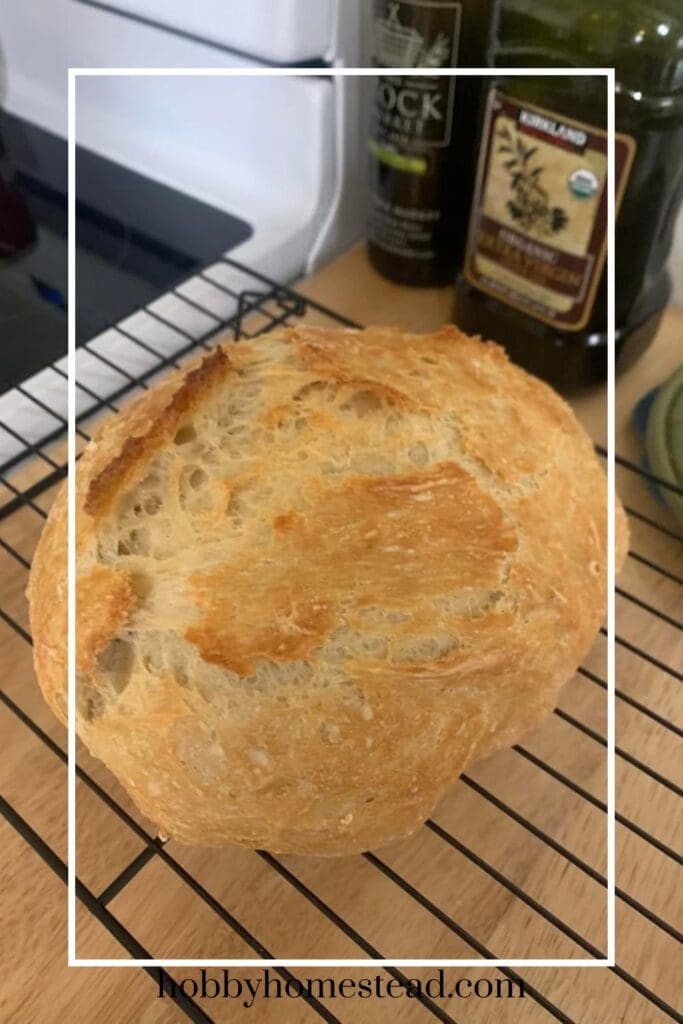Last updated on August 3rd, 2025 at 11:41 am
A healthy sourdough starter smell is the foundation of delicious homemade sourdough bread. However, beginners often struggle with identifying whether their starter is thriving or failing based on its scent.
My daughter and niece have both become quite good at growing their own fermented dough and coming up with lots of recipes for the discard. It’s healthy food you can feel good about.
In this guide, we’ll break down what different sourdough starter smells indicate, how to troubleshoot common problems, and the best way to maintain a strong, active sourdough starter.
Quick Summary
- Healthy smells. Tangy, yeasty, slightly sweet, or mild vinegar-like aroma.
- Concerning smells. Strong nail polish remover, rotten, or putrid odors.
- Common issues. Dark liquid (hooch), unpleasant odors, lack of activity, or mold.
- Key maintenance tips. Regular feedings, using fresh flour, keeping a clean jar, and maintaining a warm environment.
- Best results. Use a consistent feeding ratio, warm water, and quality ingredients like whole grain flour or organic flour.

Table of contents
Starting Sourdough Starter from Scratch
An easy sourdough starter is made from a mixture of flour and water that captures wild yeast from the environment, which will naturally ferment to become the base for many tasty sourdough breads. We have detailed help for you. How to Make an Easy Sourdough Starter.
One more tip before we get into the details of troubleshooting how the starter should smell. It can be difficult to clean up. If you’ve ever baked sourdough bread, you know that sticky bread dough has a way of clinging to every surface it touches. From bits of dough stuck in your large mixing bowl to stubborn residue in your starter jar, cleaning up can feel like the hardest part of the process.
Tips for Taming Sticky Sourdough Dough
Understanding Sourdough Starter Smells
A sourdough starter is a living culture of wild yeast and lactic acid bacteria that undergoes a fermentation process to create a bubbly, active starter. As fermentation occurs, your starter produces different scents depending on its health, feeding schedule, and type of flour used.
It may smell like beer or wine. If your sourdough starter smells like beer or wine, that’s actually quite normal! It means that your starter is fermenting well, which is a good sign.
When yeast ferments flour and water, it produces alcohol as a byproduct, hence the beer or wine-like aroma.
- Mild, tangy, and yeasty smells indicate a healthy sourdough starter.
- A vinegar-like or slightly sour smell is normal due to the presence of acetic acid.
- A strong nail polish remover scent (acetone-like) means your starter is hungry and needs feeding.
- An acidic vinegar, liquor, or booze scent is a sign that it’s hungry and over-fermenting. This happens when the natural yeasts and bacteria have consumed most of the available food (flour), leading to an excess of acidic byproducts like acetic acid (vinegar smell) and ethanol (boozy smell).
- Rotten or putrid smells signal bad bacteria or mold, requiring you to discard the starter and begin again.
How Long Should Sourdough Starter Ferment?
The fermentation time for a sourdough starter depends on various factors, including temperature, type of flour used, and feeding frequency. Here’s a general guideline:
- New Starter. It typically takes 5-7 days for a new sourdough starter to become active and ready for baking. In some cases, it may take up to 14 days to develop strong fermentation.
- Daily Fermentation Between Feedings. A mature sourdough starter at room temperature ferments for 4-12 hours before needing another feeding, depending on the ratio of flour to water and the ambient temperature.
- Cold Storage (Refrigerator). If storing in the fridge, a starter can ferment slowly for up to a week before needing to be fed.
When you are first starting your fermentation process. You may notice that it smells floury. This is normal when first starting the starter and right after feeding.
If it smells mostly like flour with little to no tangy or yeasty aroma, it might not be fully active yet. A floury smell usually means. It’s not fermenting enough. The natural yeasts and bacteria haven’t had enough time or the right conditions to develop properly.
It needs more frequent feedings. If the starter isn’t being fed often enough, it may not have enough activity to produce those classic sourdough smells.
The temperature may be too cold. If your kitchen is on the cooler side, fermentation can slow down, leading to a less developed aroma.
What can do is give it time. If it’s still young (less than a week old), keep feeding it and let it mature. Feed it regularly. Try feeding it once or twice a day, depending on how active it is. Check for bubbles. If there’s no bubbling or rising, your starter may need a boost (try using whole wheat or rye flour to encourage fermentation).
What are Indicators that Sourdough Starter is Ready?
It’s ready when it doubles and is active and bubbly and passes the float test. Depending on how cold or warm your house is, this can take anywhere from 2 to 10 hours.
This is referred to as a mature starter that has matured enough to use.
What Should Sourdough Starter Look Like?
A healthy sourdough starter should look bubbly, slightly puffy, and airy, with a consistency similar to thick pancake batter or yogurt. Here’s what to look for:
Signs of a Healthy Starter
It should be bubbly and active. You should see bubbles throughout, which indicate fermentation. It will have a slightly domed or puffy look. After feeding, the starter should rise and then gradually deflate.
Depending on the type of flour used, it may have an off-white, tan, or slightly grayish. With a mild tangy aroma. It should smell pleasantly sour, like yogurt or vinegar, but not overpowering.
Signs of Trouble
- Thin & Watery. This may indicate over-fermentation or an imbalance of hydration.
- Pink, Orange, or Moldy. Any sign of mold or strange colors means it should be discarded.
- Foul Odor (Rotten, Musty, or Harsh Alcohol Smell). A strong, unpleasant smell could mean the starter needs to be refreshed more frequently.

Troubleshooting Sourdough Starter Problems
Dark Liquid (Hooch) on Top
Hooch is a liquid layer that forms when your starter is hungry. It can be clear, gray, or dark liquid and is safe to stir back in or pour off. To fix this.
- Increase feeding frequency.
- Use a feeding ratio of equal parts water and flour by weight.
- Keep the starter in a warm spot to encourage fermentation.
Weak or Slow Activity
If your starter isn’t bubbly or rising well:
- Switch to whole wheat flour or rye flour for a boost.
- Use warm water instead of tap water (chlorine can inhibit growth).
- Maintain a consistent feeding schedule.
- Store the starter at room temperature rather than in the fridge.
Bad Odors (Rotten, Putrid, or Chemical-like)
A neglected starter can develop unwanted bacteria, leading to unpleasant odors. The best way to fix this.
- Discard most of the starter, leaving a small amount of starter in a clean jar.
- Feed it fresh flour and bottled water or warm water.
- If mold is present, it’s best to start over with a new starter.
Fruit Flies or Kahm Yeast
Fruit flies are attracted to the sweet, fermented scent of a sourdough starter, and kahm yeast (a white film) can develop in neglected starters.
- Use a rubber band and breathable cloth to cover your jar.
- Keep the jar in a cleaner, more isolated area.
- Stir and feed regularly to prevent kahm yeast from forming.
My Sourdough Starter is Too Sour
If your sourdough starter is too sour, it is likely to have an overabundance of acetic acid (sharp vinegar-like sourness) or lactic acid (milder tangy sourness). This happens when the starter ferments for too long without enough fresh food (flour) to balance out the acidity.
A cooler environment encourages more acetic acid production (sharper sourness). If you see a layer of dark liquid (hooch) on top, it means your starter is hungry and producing more alcohol and acids.
To fix, discard more starter by removing all but a tablespoon before feeding to refresh the balance. You may want to switch flour. Too much whole wheat or rye ferment faster. Use More White Flour. Switch to all-purpose flour for a milder, less sour profile.
My Sourdough Starter Grew Mold
If your sourdough starter grows mold, it’s a serious issue, and you should discard it and start fresh. Mold can be harmful, and even if it’s just on the surface, it may have spread deeper into the starter.
How to Identify Mold in a Starter
Fuzzy growth. White, green, blue, black, pink, or orange fuzzy spots are clear signs of mold.
Unusual colors. Anything besides a normal creamy or beige tone is a warning sign.
Bad smell. A rotten, musty, or off-putting odor (different from the usual tangy sourdough smell) may indicate mold contamination.
Why Did Mold Grow?
- Contaminated container. Make sure your jar is clean before adding the starter.
- Too infrequent feedings. An unfed starter becomes weak and vulnerable to mold.
- Too much moisture. A very wet starter (high hydration) can encourage mold growth.
- Dirty utensils. Always use clean spoons or spatulas to avoid introducing bacteria.

The Evolving Aromas of Sourdough Starter
A sourdough starter is a living, breathing culture that changes over time, and so does its scent. The different aromas it produces can give you valuable insights into its health and stage of fermentation.
The First Few Days (Days 1-3)
In the beginning, when you mix flour and water, the starter may have little to no smell. As fermentation begins, a range of scents may emerge, some of which might seem unpleasant or even off-putting. This is normal, as various bacteria and wild yeasts start to develop and compete for dominance.
The Transition Phase (Days 4-7)
By the fourth day, the starter’s aroma should begin to change. Any initial unpleasant smells should fade, replaced by a more yeasty, tangy scent. This shift signals that beneficial yeasts and lactic acid bacteria are establishing themselves, creating the foundation for a healthy starter.
A Fully Mature Starter (After 1 Week)
Once the starter is well-developed, typically after a week, it should have a pleasant, slightly sour aroma reminiscent of yogurt or buttermilk. This balanced scent indicates a thriving culture, ready to leaven bread.
Signs of a Hungry Starter
If your starter smells strongly of alcohol or vinegar, it’s a sign that it’s hungry. Yeast produces alcohol when it runs out of food, leading to this sharp scent. Regular feedings will keep it healthy and prevent these overpowering odors.
When a Starter is Neglected
If left unfed for too long, a starter may develop an unpleasant, rotten egg or spoiled milk smell. This is a sign that harmful bacteria have taken over, and in some cases, the starter may need to be discarded.
The changing scent of your sourdough starter is a natural part of its fermentation journey. By paying attention to these aromas, you can better understand and care for your starter, ensuring it stays active and ready for baking.
What Type of Flour to Use
When choosing flour for your sourdough starter, it’s best to use whole grain flours, like whole wheat or rye flour, in the beginning. These flours contain more nutrients and natural yeast, which help kickstart the fermentation process.
Once your starter is established, you can transition to using all-purpose flour or a mix of both. The key is to use unbleached, non-processed flour, as it preserves the natural microorganisms needed for a healthy, thriving starter.
The Type of Water Matters
If your tap water is treated with chlorine, it is NOT a good choice. Chlorine is designed to eliminate pathogens, but unfortunately, it also kills the beneficial bacteria essential for your starter’s growth.

Kitchen Temperature Matters
A sourdough starter thrives in warmth, and if your kitchen is too cold, it may become sluggish and less active. Keeping it at an optimal temperature is key to maintaining a healthy, bubbly culture.
Warmer conditions encourage fermentation and yeast activity, resulting in a happy, thriving starter. Check out the next section for tips on how to keep your starter warm.
Can I Grow a Sourdough Starter in a Cold Climate?
Yes, I can be done. We live in Wisconsin and my niece started hers in the winter. It does take longer, and she had to be consistent. She was careful when feeding her starter by weighing her ingredients. She also monitored and marked her jar so she knew how much it grew every day.
Additionally, to help with fermentation, she kept it near a heat vent in her kitchen.
Sourdough starters thrive in warm environments, ideally between 70-85°F (21-29°C). In colder temperatures, the natural yeasts and bacteria slow down, making fermentation sluggish and extending the time it takes for your starter to become active.
Here are some ideas on where to keep it in your kitchen near a stovetop, on top of the refrigerator, or inside an oven with the light on.
Here are a few other ideas. Using warm (not hot) water when feeding your starter can also give fermentation a boost. Additionally, increasing feeding frequency or using whole wheat or rye flour can encourage more activity, as these flours contain more natural nutrients and wild yeasts.
If your home is consistently cold, you might need to be extra patient, as it could take longer for your starter to develop strength and a consistent rise.

Feeding and Maintenance for the Best Results
To keep a mature sourdough starter strong.
- Use a 1:1:1 feeding ratio (e.g., 50g flour, 50g water, 50g starter).
- Stick to a consistent feeding schedule, once or twice a day at room temperature.
- Keep the starter in a warm environment (warmer temperatures help fermentation).
- Try different flours, such as whole grain flour or white bread flour, for variations.
- Use a float test to check if your starter is ready for baking—drop a small bit into water; if it floats, it’s ready.
Cleaning Your Sourdough Starter Jar
Over time, residue can build up on the sides of the jar, and if left unchecked, it can harbor unwanted bacteria or even mold.
To clean your jar, first transfer a small amount of your starter to a clean bowl to keep it safe. Then, wash the jar with hot water and a small amount of mild dish soap.
Avoid using antibacterial soaps, as they can leave behind residues that may harm the wild yeasts and bacteria in your starter. If there is dried-on starter stuck to the sides, let the jar soak in warm water for a few minutes before scrubbing gently with a sponge or brush.
Rinse thoroughly to ensure no soap remains, as any residue could disrupt fermentation. Once clean, dry the jar completely or let it air dry before returning your starter to it.
If you prefer a deeper clean, you can occasionally sanitize the jar by rinsing it with boiling water or a diluted vinegar solution, but make sure it is completely dry before use. Keeping your jar clean helps prevent contamination, ensures a fresh environment for your starter, and supports consistent fermentation.
Using Sourdough Discard
Discarding part of your starter is necessary to keep the amount of starter manageable. Instead of wasting it, you can use sourdough discard for pancakes, crackers, or muffins. A mature starter creates a tangy flavor in baked goods, making it a delicious addition to your sourdough journey.

Does Sourdough Starter Improve with Age?
Yes, well cared for starter does improve with age. A well-maintained starter becomes more robust over time as the natural yeasts and bacteria establish a balanced ecosystem.
In the early stages, a starter may be unpredictable, with varying activity levels and inconsistent rise. However, as it matures, it develops a more stable fermentation process, stronger leavening power, and deeper, more complex flavors.
Older starters tend to produce bread with better texture and a richer sourdough tang, as the mix of wild yeasts and lactic acid bacteria becomes more refined. Regular feedings and proper care contribute to this improvement, ensuring that the starter remains active and healthy.
Some sourdough bakers even pass down their starters for generations, creating unique flavors that can’t be replicated. If your starter is still young, patience and consistency will help it grow stronger over time.
Final Thoughts
Understanding the health of your Sourdough Starter Smell is key to maintaining an active and strong starter. By following these troubleshooting tips and maintaining regular feedings with fresh flour, you’ll be well on your way to baking the perfect loaf of bread. If you’re a sourdough enthusiast, taking care of your own sourdough starter is a rewarding experience that leads to delicious bread for years to come.


